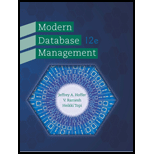
Concept explainers
(a)
Definition of Base Table.
Explanation of Solution
Base table in relational data model stores the raw data and correspond to the relations that are identified in the conceptual schema of the
(b)
Definition of Data Definition Language
Explanation of Solution
Data Definition language (DDL) is a computer language which consists of various command used for creating and modifying databases and schemas. The commonly used DDL commands are CREATE, ALTER and DROP.
- CREATE command is used to create a new table with the following syntax
- ALTER command is used to modify the existing table. The syntax is:
- DROP command is used to delete a table. The syntax is:
Create table Table name (Column definitions).
Alter table Table name add new column.
Drop table Table name
(c)
Definition of Data Manipulation language.
Explanation of Solution
Data Manipulation Language is a computer language used to modify the data in the databases. The most commonly used data manipulation commands are INSERT, DELETE and UPDATE.
- INSERT command is used to add records in the database. The syntax for INSERT command is:
- DELETE command is used to delete records from the table according to the condition. Syntax is:
- UPDATE command is used to update the records in the database. Syntax is:
Insert into table Table name(columns) values(values)
Delete from table Table name where(condition)
Update Table name set (column = value) where(condition)
(d)
Definition of Dynamic view.
Explanation of Solution
Dynamic view is a kind of virtual table that is created as per request of user dynamically. Dynamic view cannot be considered as a temporary table. In fact, the definition of dynamic view is stored in the system catalog and as a result of SQL query, the content of the view is materialized.
(e)
Definition of Materialized view
Explanation of Solution
Materialized view is different from Dynamic view. Here replicas and copies of data are created on the basis of SQL queries in the same manner as that of Dynamic views. Materialized views are stored physically on the disk.
(f)
Definition of referential integrity constraint.
Explanation of Solution
Refential Integrity constraint is the concept used in relational database which ensures that the tables in the database are in consitent state. This statement means that if there is any foreign key used in the database, it must be in agreement with the primary key which is referenced from that foreign key. Any changes in primary key must be updated in the foreign key also.
(g)
Definition of Relational DBMS
Explanation of Solution
Relational Database Management System (RDBMS) is a type of DBMS which is used for the data stored in relational databases in the form of tables(combunation of rows and columns). RDBMS is manily used to store the data related to manufacturing, finance, logistic and other applications. It uses SQL commands to access the daatbases.
(h)
Definition of Schema.
Explanation of Solution
Schema is a structure or architecture of the database which is supported by the DBMS. It is considered as the blueprint of how the database is constructed. The schema is stored in the data dictionary generally by the database. It defines the objects in the databases.
(i)
Definition of Virtual Table.
Explanation of Solution
Virtual table is constructed automatically as per the need of the DBMS and are not maintained as real data.
Want to see more full solutions like this?
Chapter 6 Solutions
Modern Database Management (12th Edition)
- I need help in explaining how I can demonstrate how the Laplace & Inverse transformations behaves in MATLAB transformation (ex: LIke in graph or something else)arrow_forwardYou have made the Web solution with Node.js. please let me know what problems and benefits I would experience while making the Web solution here, as compared to any other Web solution you have developed in the past. what problems and benefits/things to keep in mind as someone just learningarrow_forwardPHP is the server-side scripting language. MySQL is used with PHP to store all the data. EXPLAIN in details how to install and run the PHP/MySQL on your computer. List the issues and challenges I may encounter while making this set-up? why I asked: I currently have issues logging into http://localhost/phpmyadmin/ and I tried using the command prompt in administrator to reset the password but I got the error LOCALHOST PORT not found.arrow_forward
 Database System ConceptsComputer ScienceISBN:9780078022159Author:Abraham Silberschatz Professor, Henry F. Korth, S. SudarshanPublisher:McGraw-Hill Education
Database System ConceptsComputer ScienceISBN:9780078022159Author:Abraham Silberschatz Professor, Henry F. Korth, S. SudarshanPublisher:McGraw-Hill Education Starting Out with Python (4th Edition)Computer ScienceISBN:9780134444321Author:Tony GaddisPublisher:PEARSON
Starting Out with Python (4th Edition)Computer ScienceISBN:9780134444321Author:Tony GaddisPublisher:PEARSON Digital Fundamentals (11th Edition)Computer ScienceISBN:9780132737968Author:Thomas L. FloydPublisher:PEARSON
Digital Fundamentals (11th Edition)Computer ScienceISBN:9780132737968Author:Thomas L. FloydPublisher:PEARSON C How to Program (8th Edition)Computer ScienceISBN:9780133976892Author:Paul J. Deitel, Harvey DeitelPublisher:PEARSON
C How to Program (8th Edition)Computer ScienceISBN:9780133976892Author:Paul J. Deitel, Harvey DeitelPublisher:PEARSON Database Systems: Design, Implementation, & Manag...Computer ScienceISBN:9781337627900Author:Carlos Coronel, Steven MorrisPublisher:Cengage Learning
Database Systems: Design, Implementation, & Manag...Computer ScienceISBN:9781337627900Author:Carlos Coronel, Steven MorrisPublisher:Cengage Learning Programmable Logic ControllersComputer ScienceISBN:9780073373843Author:Frank D. PetruzellaPublisher:McGraw-Hill Education
Programmable Logic ControllersComputer ScienceISBN:9780073373843Author:Frank D. PetruzellaPublisher:McGraw-Hill Education





